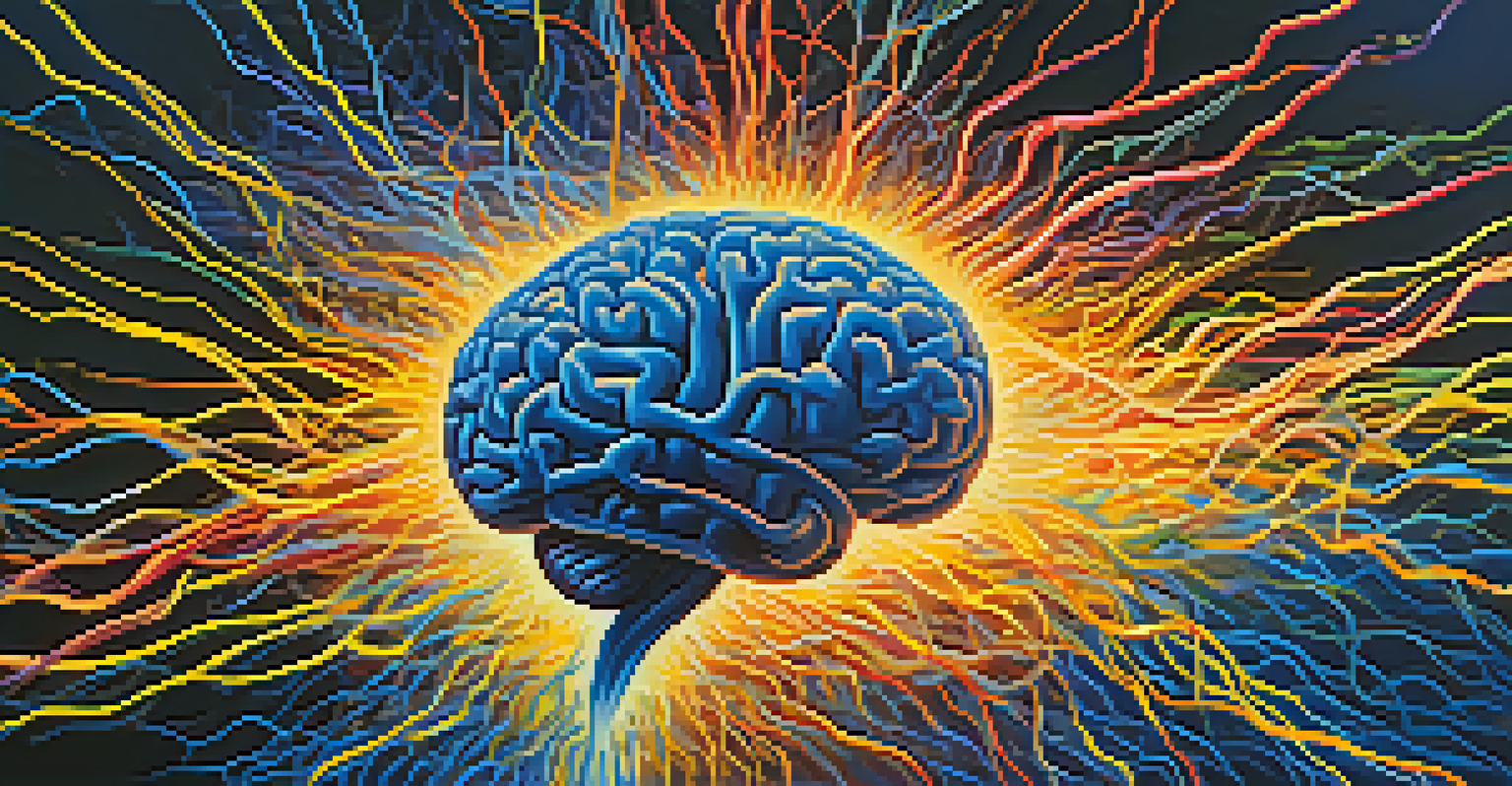Hallucinogens: Catalyst for Change in Brain Plasticity

Understanding Brain Plasticity and Its Importance
Brain plasticity, or neuroplasticity, refers to the brain's ability to reorganize itself by forming new neural connections throughout life. This adaptability is vital for learning, memory, and recovery from injuries. Think of it like a city that builds new roads to improve traffic flow; similarly, our brains create new pathways to enhance communication between neurons.
The brain is a wonderful organ. It starts working the moment you get up and does not stop until you get into the office.
This phenomenon is particularly important in a world where mental health conditions, such as depression and anxiety, are prevalent. By understanding how the brain can change and adapt, we can unlock new methods for treating these disorders. The more we know about brain plasticity, the better equipped we are to harness its potential for healing and growth.
Hallucinogens, substances that alter perception and cognition, have recently garnered attention for their role in promoting brain plasticity. Research is uncovering how these compounds can facilitate profound changes in the brain, offering hope for innovative therapeutic approaches.
What Are Hallucinogens and How Do They Work?
Hallucinogens are a diverse group of psychoactive substances that can cause significant changes in perception, mood, and thought processes. Some well-known examples include psilocybin (found in magic mushrooms), LSD, and mescaline. They work primarily by interacting with serotonin receptors in the brain, leading to altered states of consciousness.

When ingested, these substances can produce vivid visual and auditory hallucinations, along with profound emotional experiences. It’s akin to stepping into a painting where the colors and forms are alive, allowing individuals to perceive the world in entirely new ways. This shift in perception can spark creativity and introspection, revealing insights that might otherwise remain hidden.
Brain Plasticity Enhances Healing
Neuroplasticity allows the brain to reorganize and form new connections, which is crucial for learning and recovery from mental health disorders.
Recent studies suggest that these alterations can also affect brain connectivity. Hallucinogens seem to promote synaptogenesis—the formation of new synapses—enhancing the brain's capacity to forge new connections and pathways, which is a cornerstone of brain plasticity.
The Science Behind Hallucinogens and Neuroplasticity
Research into how hallucinogens influence brain plasticity is still in its infancy, but early findings are promising. Studies have shown that substances like psilocybin can increase the expression of proteins associated with neuroplasticity, such as brain-derived neurotrophic factor (BDNF). This protein plays a crucial role in the survival of neurons and the growth of new synapses.
The mind is everything. What you think you become.
Moreover, these substances can lead to a phenomenon known as 'resetting' the brain's default mode network. This network is often hyperactive in individuals with depression, contributing to rumination and negative thought patterns. By dampening this activity, hallucinogens may open the door to more adaptive thought processes, fostering mental resilience.
These effects suggest that hallucinogens could serve as powerful tools in therapeutic settings, particularly for mental health disorders where neuroplasticity is compromised. Imagine giving someone a fresh canvas to paint their thoughts anew; hallucinogens might just offer that opportunity.
Therapeutic Potential of Hallucinogens
The therapeutic potential of hallucinogens is gaining traction in the mental health community. Clinical trials are exploring their use in treating conditions such as PTSD, depression, and anxiety. As research unfolds, we are beginning to see how these substances can catalyze change in the brain, leading to lasting improvements in mental health.
For instance, patients participating in psilocybin-assisted therapy often report significant reductions in depressive symptoms after just a few sessions. The combination of the hallucinogen experience with psychotherapy appears to amplify the therapeutic effects, creating a powerful synergy that promotes healing.
Hallucinogens Promote Neuroplasticity
Substances like psilocybin can stimulate brain plasticity by increasing the production of proteins that support the growth of new neural connections.
This potential for transformative change is why many researchers are advocating for the integration of hallucinogens into mainstream therapeutic practices. It’s a reminder that sometimes, the path to healing requires thinking outside the box—or, in this case, outside the mind.
Challenges and Considerations in Research
Despite the exciting possibilities, the research surrounding hallucinogens is not without its challenges. Legal restrictions, stigma, and a historical context of misuse have hindered comprehensive studies. Researchers often face hurdles in securing funding and approvals, which can slow down the pace of discovery.
Moreover, the experiences induced by hallucinogens can vary widely between individuals, making it difficult to predict outcomes. Factors such as dosage, set (mindset), and setting (environment) all play crucial roles in the experience and its therapeutic potential. This variability necessitates a careful and nuanced approach to research and application.
Understanding these challenges is crucial as we navigate the resurgence of interest in hallucinogens. It reminds us that while the potential is vast, the path forward requires caution, diligence, and a commitment to ethical research practices.
Personal Accounts: Journeys with Hallucinogens
Personal narratives can shed light on the profound effects of hallucinogens on individual lives. Many people report transformative experiences that have shifted their perspectives, helped them confront past traumas, or sparked a renewed sense of purpose. These stories often highlight the emotional and cognitive breakthroughs that can occur during hallucinogenic experiences.
For example, someone may recount how a psilocybin experience allowed them to confront long-buried emotions, leading to a newfound clarity about their life choices. Such accounts underscore the potential of hallucinogens to facilitate deep introspection and personal growth, acting as catalysts for change.
Therapeutic Potential of Psychedelics
Emerging research suggests hallucinogens may effectively treat mental health issues like PTSD and depression, especially when combined with psychotherapy.
These personal journeys resonate with those seeking alternative paths to healing in an increasingly complex world. They remind us that every experience is unique, and the potential for change lies in the willingness to explore the depths of our minds.
The Future of Hallucinogens in Mental Health Treatment
As research continues to expand, the future of hallucinogens in mental health treatment looks promising. With growing acceptance within the scientific community and increasing public interest, there is potential for these substances to become a cornerstone of therapeutic practices. This shift could revolutionize how we approach mental health care.
Future studies will likely focus on refining treatment protocols, understanding the mechanisms behind their effects, and determining the best practices for their use. There’s a sense of excitement in the air, as researchers and clinicians work together to unlock the full potential of these compounds.

Ultimately, the integration of hallucinogens into mental health treatment could provide individuals with new tools for healing and self-discovery. It’s an evolving narrative that invites us to rethink our relationship with these substances and their role in fostering brain plasticity and personal transformation.